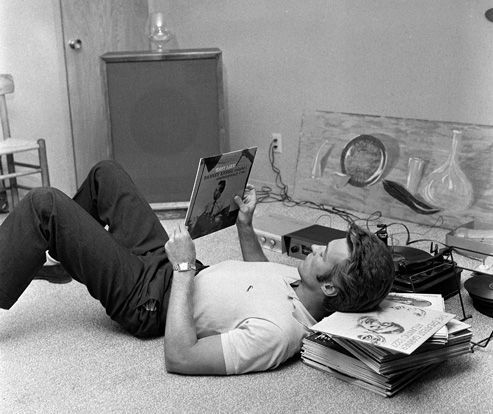 Great news! Spotify Is Adding “Social Listening” to Let Friends Listen to Music Simultaneously.
Great news! Spotify Is Adding “Social Listening” to Let Friends Listen to Music Simultaneously.
This will fix everything.
Perhaps you’re not old enough to remember listening to music. Really listening. Like most of my Boomer contemporaries, I’d retreat to my room in my high school and college years, close the door, put on an album, and listen. That was the activity. No multi-tasking – homework, talking on the phone, tidying up, paging through a magazine. Nothing. I sat and listened.
I heard the music and dreamed. Unbridled emotion surfaced. I thought about whatever girl I had a crush on at the moment, fantasizing about our deep, perfect love and happy life together, for we were meant to be. Words and music could send me into a state of euphoria or to the verge of tears. Sometimes in the same song. I could feel part of something bigger or completely isolated. But I always felt something, and something I might very well have missed just by going about my day-to-day business. Music was both meditation and therapy, well before I knew what either of those things were.
This experience was often shared with friends as well. An after-school activity might be going to someone’s house, putting on an album, and listening. (Okay, maybe we got high first. But still…) Get up, flip the record over and repeat. I have indelible memories of hearing many great songs and artists for the first time. Sam Galey turning me on to some new guitar players (Hendrix & Clapton) and a band called the Grateful Dead. My best friend Kyle discovering and sharing protest songs like Country Joe’s “Fish Cheer” or Sympathy for the Devil by the Stones. And I remember Bob Birch putting on Buffalo Springfield’s “Sit Down I Think I Love You” and telling me how the song made him realize he was madly in love with a girl in our class. This notion lasted a week, she didn’t like him anyway, and he got over it immediately, but I’ll never forget his emotional intensity in that moment.
This was a time when we had to go to the music. We had many vices by no devices. Now the music comes to us. I am amazed by people who work with music blasting through their earbuds. One of my USC students told me that she listens to podcasts while at work. It’s all background, and all personal. While there is still the communal experience of live concerts, the very nature of our technology has shifted the focus of music to the individual.
Has it all come back around, now that Spotify technology allows us to share a song with a friend and listen to it at the same time, despite that we may not be in the same place? I don’t think so. We’re living in the Upside Down. The Bizarro world of Superman where everything is its opposite.
Come on people now,
Smile on your brother,
Everybody get together,
Got to love one another right now.
That Youngblood’s hit from the 1960’s and its central premise are remnants of a time past. A time with striking parallels – and huge differences – to the present day.
The Vietnam War had polarized the nation. President Lyndon Johnson was so unpopular for its escalation that he had to withdraw his candidacy for re-election in 1968. And that gave us Richard Nixon, champion of the “Silent Majority,” the good people of the heartland whose patriotism, humility and basic decency were overshadowed by the cosmopolitan elites.
Just four years earlier, the groundwork for Nixon’s (and Trump’s) election was laid with the Republican nomination of Barry Goldwater for president, who was quoted as saying, “Sometimes I think this country would be better off if we could just saw off the eastern seaboard and let it float out to sea.”
Nixon’s choice of Vice President, Spiro Agnew, who resigned in disgrace, was also adept at spewing Trump-like nonsense:
“There are people in our society who should be separated and discarded.”
“A spirit of national masochism prevails, encouraged by an effete corps of impudent snobs who characterize themselves as “intellectuals.”
“Some newspapers are fit only to line the bottom of bird cages.”
And then, there was the infamous bumper sticker.

Any of this sound familiar?
Still, we’re in the Upside Down.
The modern-day Silent Majority is not a majority – if it ever was in Nixon’s day. And they certainly aren’t silent. The radical right has its own news network that somehow is able to set all the talking points while the so-called “mainstream” or “left-wing” media plays the game of presenting “both sides.” Better to be balanced than to report facts. Actually, fiction is the new fact. Not only were video games behind the mass shooting in El Paso, but “mental illness and hatred pulls the trigger, not the gun.”
And rather than suffer proudly and stoically, they flock to Trump’s Nuremberg rallies, working themselves up into a cathartic frenzy over their perceived victimhood and the promise of never being “replaced.”
Where is the counter-culture? You know, the people who back radical policies like universal access to health care, elections free from foreign interference, building alliances with our allies rather than “falling in love” with dictators, and avoiding the temptation to separate children from their parents and put them in cages. (A Trump supporter told me recently, full of righteous fury, that “Obama built those cages!”
Of course, this “counter-culture,” is indeed the majority of Americans. And they too are not silent. Just log on to Twitter.
But what about real life? Where are the protests? Lots of angry tweets but no one in the streets protesting (choose any of the following) mass shootings, racism, the shameful treatment of immigrants, attacks on the free press, 10,000+ lies and counting, siding with foreign despots – enemies of our country – over our own intelligence community and career civil servants, violations of election law (remember Stormy Daniels hush money?), the refusal to even acknowledge foreign interference in our elections? Not to mention obstruction of justice in plain sight.
This is time where we need a sense of community more than ever. We need to talk, socialize, and share experiences. Twitter is a wonderful tool to let off steam and provide the illusion that your voice makes a difference, but it’s just shouting in a void. As the blogger Bob Lefsetz once put it, “Tweeting is akin to calling for your mommy at Yankee Stadium. The most popular on Twitter have an audience, (but) no one wants to hear the musings of the wannabe.”
Without protests, I guess there can’t be protest songs. So perhaps I shouldn’t wonder where the songs of peace, brotherly love and protest are now. They’re certainly not on the Billboard Charts today. “Get Together” made it to number 5 on the charts in 1969, and here’s a top ten list of 60’s protest songs, to which I could add dozens more.
Trump Nation is indeed living in the moment. But not the rest of us, the majority of Americans. We are posers and slacktivists. Not even responsible citizens.
As this is ostensibly a blog about marketing, I’ll digress for a moment to look at the idea of mindfulness in the context of Big Data. Like the technology that allows us to carry virtually every recorded song with us nearly any place we go, Big Data has enriched our understanding of consumer behavior beyond our wildest dreams. But it can also a distraction, a mindless pursuit of “facts” that completely ignores the need to be in the moment with consumers, to talk to them face-to-face, listen to not just what they say but how they say it, and to leave space for the spontaneity from which deep emotion and new ideas can emerge.
Being in the moment is precisely the opposite of being in Big Data.
We are passive, tweeting and dishing the latest dirt on Trump while doing nothing. We allow our representatives in Congress to dither. We don’t read enough. We don’t stay informed. We worry too much about appearances and “electability” than substance. And we are too isolated from each other.
Being in the moment is to be with people in real time. Being in the moment is to focus. And being in the moment inspires the changes from within that will bring about the changes in the world at large.
Which brings me around to piece from the New York Times a few months back that described the emergence of “Japanese-style listening bars, where D.J.’s spin carefully selected records for a hushed audience.” Here, the writer, Ben Ratliff, describes hearing “the first side of “Now That Everything’s Been Said,” the 1968 record by the City, Carole King’s short-lived Los Angeles folk-rock band.”
But here I really heard it. I understood something about the tactility and enlivening qualities of sound better than ever before: Sound can be a three-dimensional space in which to put your body, and in which your body may be acted upon and opened up, even when you are sitting still. I seemed to understand the physics of it: tones as standing waves, and me in the middle of them, one of them. Or, if you prefer the language of another sense, it was like seeing colors after knowing only grays.
That’s being in the moment. That kind of inspiration doesn’t come from Big Data, nor can it be streamed. Imagine, leveraging that kind of emotional power for your work, for society and for whatever else you care about.



